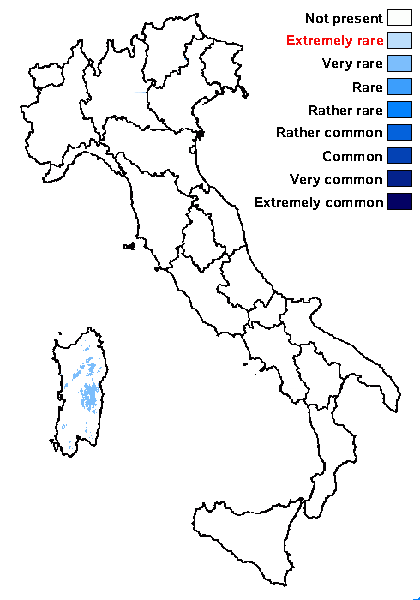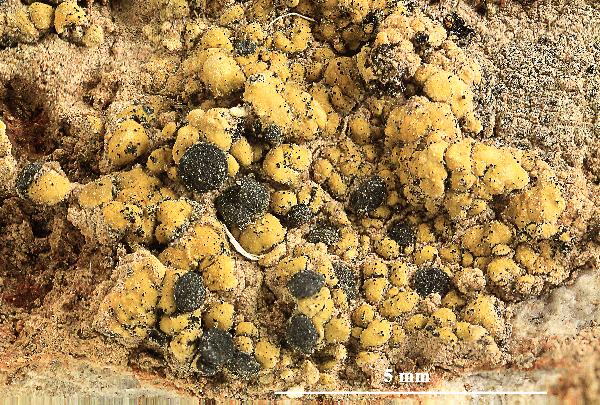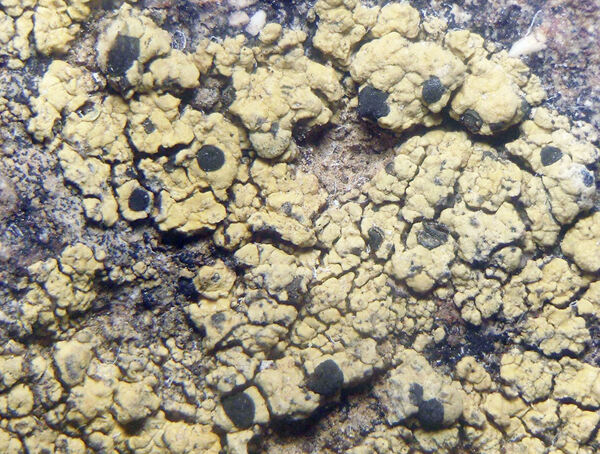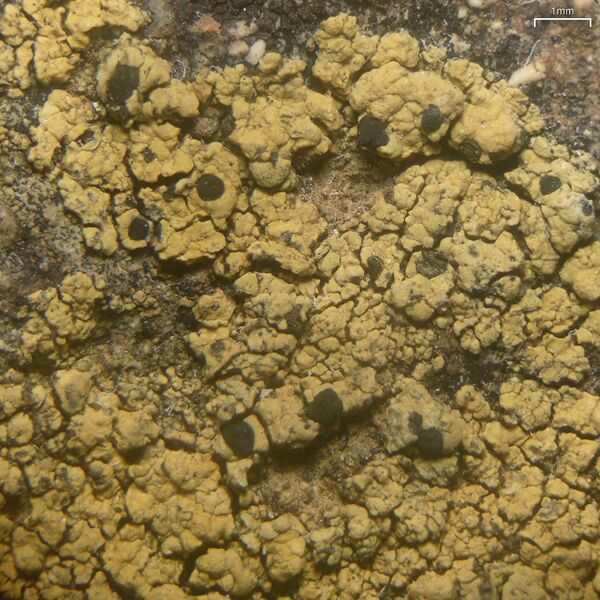Tetramelas concinnus (Th. Fr.) Giralt
in Giralt & al., Nova Hedwigia, 89: 330, 2009. Basionym: Buellia concinna Th. Fr. - N. Acta Reg. Soc. Sci. Upsal., ser. 3, 3: 232, 1860.
Synonyms: Buellia nodulosa (Lynge) H. Magn.; Buellia subconcinna (Vain.) Zahlbr.; Buellia subviridescens (Nyl. ex Th. Fr.) Vain.; Lecidea perlutescens Nyl. ex Th. Fr.; Lecidea subconcinna Vain.
Distribution: C - Sar (Rizzi & al. 2011).
Description: Thallus crustose, episubstratic, of dispersed to contiguous areoles, yellowish, often growing on the thalli of other crustose lichens. Medulla I- or I+ blue. Apothecia lecideine, black, 0.5-1 mm across, adnate to sessile and constricted at base, with a flat to strongly convex disc, and a thick, prominent, sometimes finally excluded proper margin. Proper exciple Dispersa-type, 40-70 µm wide laterally, dark brown throughout, of radially arranged hyphae, the inner part of long-celled, parallel, strongly agglutinated and thick-walled hyphae, the outer part of short-celled, isodiametric hyphae without intercellular spaces; epithecium brown; hymenium colourless, not inspersed with oil droplets, 60-90 µm high; paraphyses distinctly capitate, the apical cells to 7 µm wide; hypothecium dark brown. Asci (4-)8-spored, clavate to cylindrical-clavate, the apical dome K/I+ dark blue with a pale, conical-pointed apical cushion (axial mass), the wall I-, but the thin outer gel I+ blue, Bacidia-type. Ascospores 1(-3)-septate, brown, oblong, often curved, 13-21 x 6.5-9(-10) µm, Physconia-type (when young with tendencies to the Callispora-type), with a microrugulate to rugulate ornamentation, and ontogeny of type C (subapical inner wall thickenings produced before septum formation). Pycnidia black, immersed. Conidia bacilliform, 4-5.5 µm long. Photobiont chlorococcoid. Spot tests: thallus , K+ orange, C+ orange, KC+ orange, UV+ orange. Chemistry: arthothelin, trichlor-O-methyl norlichexanthone.Note: a cool-temperate to boreal-montane, circumpolar species found on steeply inclined surfaces of hard siliceous rocks in upland areas, often starting the life-cycle on other crustose lichens; probably occurring also in the Alps.
Growth form: Crustose
Substrata: rocks
Photobiont: green algae other than Trentepohlia
Reproductive strategy: mainly sexual
paras crustose and foliose lichens when young
Commonnes-rarity: (info)
Alpine belt: absent
Subalpine belt: absent
Oromediterranean belt: absent
Montane belt: very rare
Submediterranean belt: absent
Padanian area: absent
Humid submediterranean belt: absent
Humid mediterranean belt: absent
Dry mediterranean belt: absent

Predictive model
Growth form: Crustose
Substrata: rocks
Photobiont: green algae other than Trentepohlia
Reproductive strategy: mainly sexual
paras crustose and foliose lichens when young
Commonnes-rarity: (info)
Alpine belt: absent
Subalpine belt: absent
Oromediterranean belt: absent
Montane belt: very rare
Submediterranean belt: absent
Padanian area: absent
Humid submediterranean belt: absent
Humid mediterranean belt: absent
Dry mediterranean belt: absent

Predictive model
 INDEX FUNGORUM
INDEX FUNGORUM
 GBIF
GBIF







